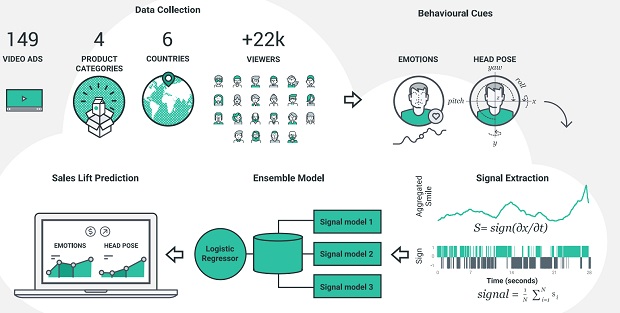A study by Realeyes and Mars has revealed emotion measurement technology can distinguish between ads which deliver high or zero/low sales lift with 75% accuracy.

The study involved 149 ads across 35 brands and 22,334 people in six countries. Realeyes measured how people felt while they watched the ads by using artificial intelligence to analyse their facial expressions through their webcams (with their consent).
The study was designed in collaboration with the Mars Marketing Laboratory at the Ehrenberg-Bass Institute for Marketing Science.
Realeyes’ emotion data was cross-referenced with Mars, Incorporated’s known sales lift data for each ad to investigate the relationship between emotions and sales performance. This created the largest emotional dataset linked to real business outcomes currently in existence.
The analysis showed that emotions data could be used to correctly identify whether the ads tested had a “no to low” or “high” impact on sales 75% of the time.

“We wanted to see if our emotion measurement technology could distinguish between high and low performing ads. Being able to identify strong creative with high sales impact enables advertisers to push these ads, and avoid putting media spend behind those with low, or worse – no sales impact. It’s about spending campaign budgets more effectively, optimising ad creation and media buying at no additional cost,” said Mihkel Jäätma, Realeyes’ CEO. “Just think – an algorithm can detect how people feel about an advert by tracking their facial expressions, and that can tell us whether that ad will sell or not – that’s exactly what our scientists been working to achieve.”
Linking Emotions to Sales from Realeyes on Vimeo.
Realeyes technology measures the micro-movements of the face and uses computer vision and machine learning to analyse them, focusing on expressions of happiness, surprise, confusion, disgust, engagement, and behaviours such as how and when people move their head.
Realeyes, founded at Oxford University, is looking at how the insights from the Mars, Incorporated study – the scale of which surpassed any previous work done in this area – could be expanded in order to further the advance of predictive analytics linked to real business outcomes. This work reconfirms the value of reading people’s unconscious, unbiased facial expressions and measuring their emotional reaction to advertising. Truly understanding the consumer’s response to advertising enables better revenue-driving choices, and reduces wasted media spend on weak videos.
This year, the Advertising Research Foundation has established “The Innovators A-List” for creating scalable, disruptive solutions for marketing and advertising. 85 companies went through a rigorous vetting process and Realeyes was one of only 32 to be nominated – for its innovative technology of emotion analytics.
Jäätma is presenting the full results of the research at the ARF’s Annual Conference in New York this week.
Source: www.realeyesit.com
